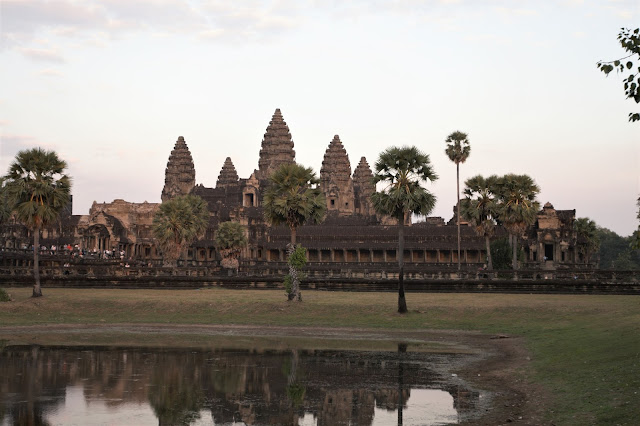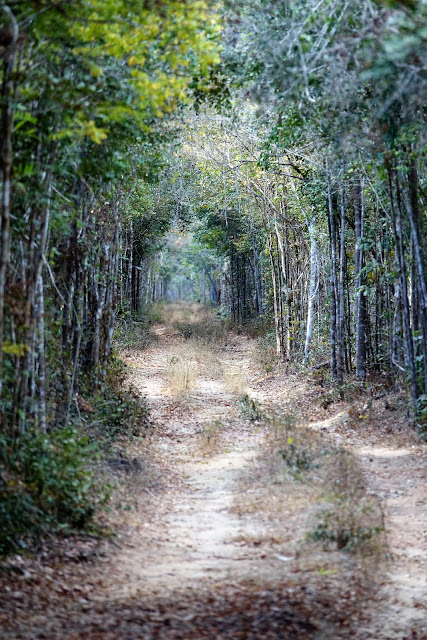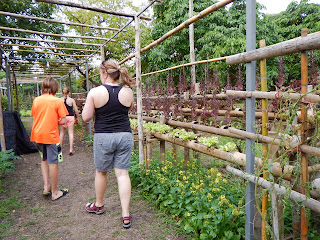Angkor in Pictures
The main reason we put Cambodia on our list of places to visit was the same reason most people travel there - to see the spectacular ruins of the ancient Khmer civilization known as Angkor. They have such global historical, architectural and artistic significance that they were designated a UNESCO World Heritage Site in 1992. The visit did not disappoint. This place is AMAZING, but with so much to take in (so many ruins and spread out over 400 km2) it was also a bit intimidating. We'd heard from a few different travellers that "once you've seen one temple you've seen them all". We wanted to avoid feeling the same way (and we did) yet feel like we'd really got a good sense for what makes these ruins so special, so Kim and I did quite a bit of reading about what the highlights are and involved Lucas and Maya a bit with their choices of temples to see so that they would stay interested. We had a great day despite feeling exhausted by the end of it.
Angkor was the centre of the Khmer empire from the 9th to the 15th centuries, connecting cities, farmland, temples, reservoirs and canals to the capital city of Angkor Thom. Angkor Wat, probably the most famous ruin of all, is a massive temple complex and the largest religious monument in the world. It was built in the 12th century as a Hindu temple and transformed by successive kings to a Buddhist one. We spent about 5 hours there one evening and the following morning before moving on to take in some of the other significant ruins in the area. We started with Angkor Wat and moved onto the nearby temples of Bayon, Ta Prohm and Preah Kahn. All are within a short drive of the town of Siem Reap where we stayed for 4 days while visiting Angkor as well as the floating villages on Tonle Sap Lake. I've chosen a few of our best photos from our time at the ruins to include here and added (mostly short) descriptions.

Angkor was the centre of the Khmer empire from the 9th to the 15th centuries, connecting cities, farmland, temples, reservoirs and canals to the capital city of Angkor Thom. Angkor Wat, probably the most famous ruin of all, is a massive temple complex and the largest religious monument in the world. It was built in the 12th century as a Hindu temple and transformed by successive kings to a Buddhist one. We spent about 5 hours there one evening and the following morning before moving on to take in some of the other significant ruins in the area. We started with Angkor Wat and moved onto the nearby temples of Bayon, Ta Prohm and Preah Kahn. All are within a short drive of the town of Siem Reap where we stayed for 4 days while visiting Angkor as well as the floating villages on Tonle Sap Lake. I've chosen a few of our best photos from our time at the ruins to include here and added (mostly short) descriptions.
Angkor Wat shortly after sunset
A Buddhist monk contemplating his existence (??) while
looking out over the moat surrounding Angkor Wat
looking out over the moat surrounding Angkor Wat
In fact we saw many monks on our travels throughout Thailand and Cambodia. Some we saw in the temples where they lived and 'worked'; others, we think, were either on personal pilgrimages or being tourists just like us. The photo above wasn't an intrusion on this particular monk's space or state of mindfulness because he was actually posing. Just out of sight of the photograph is another monk holding a smartphone taking his picture. We quickly cast aside our 'western' stereotypes' of monks as gentle and passive and living with the sole purpose of seeking enlightenment while living the simplest of existences. Regularly we saw monks riding busses and scooters, working on computers, talking on their cell phones and taking pictures just like other people and the rest of us tourists.
Sunrise view of Angkor Wat's central pyramid - the symbol for Mt. Meru - centre of the Hindu universe
The throngs of people visiting Angkor Wat to get a glimpse of the sunrise
behind the temple/city. Somewhere in this crowd are Maya and Kim.
behind the temple/city. Somewhere in this crowd are Maya and Kim.
The stunning Angkor Wat!
Just a cool pic of Maya and dad at Angkor Wat next to some of the artwork and architectural features (lathe turned window columns) found there.
One of the many artistic examples of engraved mythological stories that form the
huge length of bas-reliefs around Angkor Wat
The bridge approaching the entry gate to Angkor Thom. It is lined on one side by a
row of smiling Gods, and on the other by a row of demons.
One of the tower's faces smiling down on Lucas
Bayon Temple at Angkor Thom. The distinctive features of this temple
are the many towers and their serene/smiling faces.
The incredibly photogenic Bayon towers
Maya posing at Bayon
Looking out to the street from inside the wall at Bayon. Wait... what??
Ta Keh, a tall imposing temple directly across the street from a row of outdoor eateries where we sat
down for lunch. While waiting for our food, Lucas and Maya decided they weren't hot and tired
enough so they quickly climbed to the top before our meals arrived. Lucas is the speck of green in
the centre near the top.

Double columned covered walkway leading toward
the centre of Ta Prohm Temple
Thikpot, silk-cotton, strangler-fig and gold apple trees grow
throughout this temple, which has been left in much the same
way as it was found except for restoration works aimed at stabilizing the
crumbling walls and archways, and removing undergrowth.
Many of the fallen stones still lay on the ground to preserve the 'picturesque' ancient
jungle quality setting.
jungle quality setting.
A strangler-fig tree that seems to be winning its battle with this temple wall
A moment of shenanigans on the way into Prea Khan
Artwork on the walls of Prea Khan showing evidence of some restoration work
Visiting Angkor was truly an unforgettable experience for all four of us. We learned so much about the ancient Khmer civilization, especially their religion, architecture and art, and we now understand what all the fuss is about at this UNESCO site.
























Comments
Post a Comment